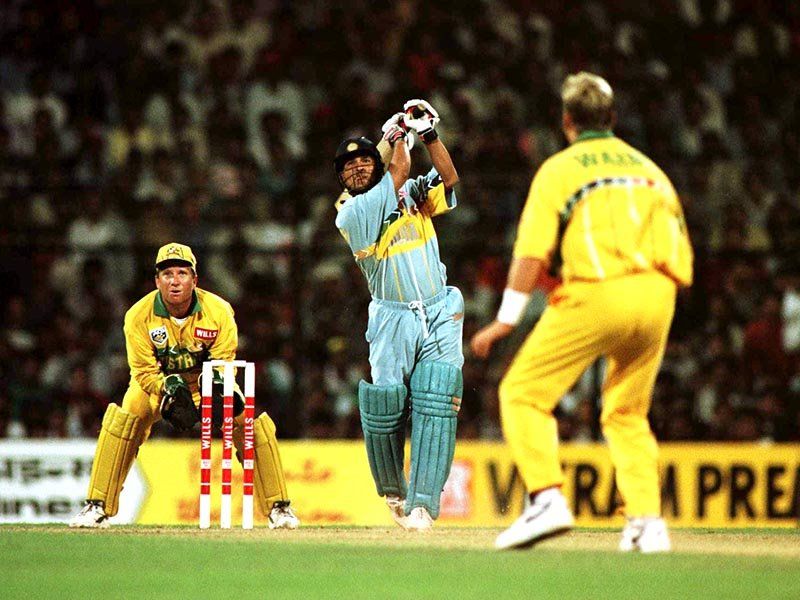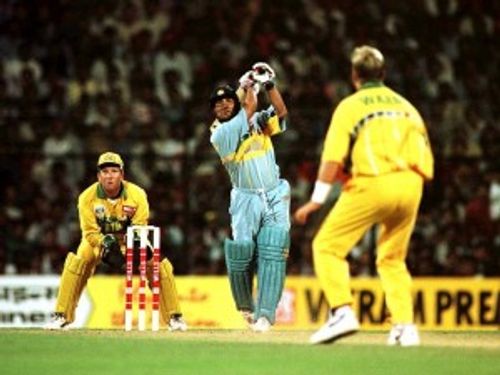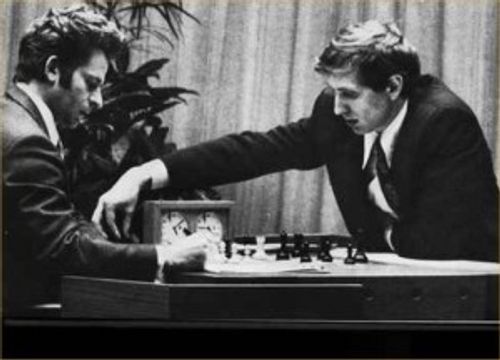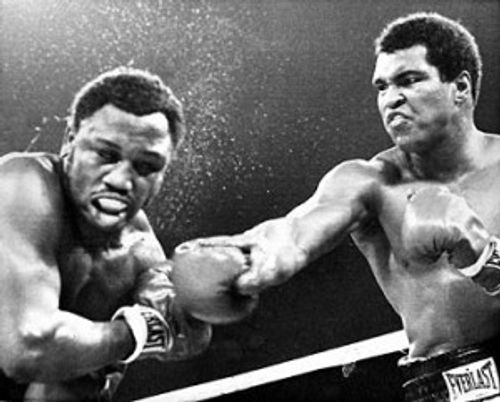
This means war: The greatest individual rivalries in sports (Part 1)
Now, I know using the words ‘war’ and ‘sports’ in the same sentence is not kosher unless we’re talking about cockfights in rural India or the Ashes or…Kevin Pietersen. The point is, a sport is a discipline, first and foremost. Then it is an activity that involves grit, doggedness, integrity and competitiveness. Then comes the entertainment part, the stuff that sells it, the juice, the drama, the masala of it all. Sometimes, after all of the aforesaid has been accounted for, comes this cute set of words that raise the stakes, magnetize the audience, and make headlines – prestige, vendetta, hardcore mind-games, rivalries.
Without further ado, here’s a package of the world’s most famous sporting rivalries since Bheema kind of…tore Jarasandha into two pieces in a wrestling match 5000 years ago (trust me, nothing has ever come remotely close since, but that is only because homicides are universally punishable today).
So we begin, in ascending order of intensity.
FOUR: Sachin Tendulkar and Shane Warne

A romance that shall be reminisced, read and talked about for as long as the game of cricket lives on. Sachin Tendulkar, arguably the greatest batsman to ever take the field, standing at the crease with a stance that suggests utmost concentration, while a blonde 6-footer ambles in with the leather, who just happens to be one of the greatest spin-bowlers of all time, Shane Warne.
It was no love at first sight; Warne had quite the forgettable Test debut at the Sydney Cricket Ground against India in 1992. He took one wicket and conceded 150 runs. The 19-year-old Tendulkar scored a century in that one. Round One was his.
After that, the Maestro and the Wizard squared off in 12 Tests and 17 One-Day Internationals. An entire generation stood up and watched epic battles unfold all over the world where these two guys were involved – Chennai, Sydney, Melbourne, Sharjah, Kolkata.
In the spring of 1998, Australia had a disastrous tour of India, following which India was labeled the ‘Final Frontier’ by the Aussie skipper Steve Waugh. In the first Test at Chennai, Warne made Tendulkar dance during India’s first innings. The leg-breaks were skirting dangerously close to the batsman’s pads and Tendulkar was swinging at everything that moved. He was out in 7 balls, and Warne had a couple of words to say about that. Tendulkar answered in the second innings. A cool 155 and the ‘Player of the Match’ award. Warne was belted for 10 fours and a 6.
Then came Mumbai, and again Tendulkar came out on top. Two years later, Warne single-handedly demolished the entire Indian batting line-up in Melbourne while Tendulkar was left scavenging for partners. Meanwhile in ODIs, the battles were of an entirely different nature. The 1998 Sharjah Cup had both Warne and Tendulkar at their feared peaks. The Indian piled up two consecutive centuries while Warne’s curve-balls proved impossible to negotiate for anyone else facing them. We all know the ‘Case of the Tendulkar Nightmares’.
Australia’s tour of India in 2004 was also Australia’s conquest of the Final Frontier, and Warne was one of the chief architects of victory. Tendulkar cut and pulled, but remained largely ineffective.
And so cricket’s classic rivalry remains on an even scale. Both players have incredible respect for each other, and as Ravi Shastri would say at the end of the day, cricket is the real winner.
THREE: Bobby Fischer and Boris Spassky

1972 was smack in the middle of the Cold War, just one of those times when the USA and/or erstwhile USSR could nuke each other out. On July 11 that year, two men from either country sat down for a game of chess, while bewildered Generals watched with a finger on some very important buttons.
The World Chess Championship of 1972 was dubbed as the ‘Match of the Century’, perhaps because the citizenry of neither country hoped to live to see another century.
Until then, chess was supposed to be Soviet Union’s birthright. It was part of their political system, they were better equipped to sit at one place for long hours at a stretch, every world champion had been of Soviet origin barring the first…whatever the reasons, no one dared challenge a guy from that part of the world for a game.
So when an eccentric American, Robert James “Bobby” Fischer, challenged the reigning champion of 3 years, Boris Spassky, at a time when the world could have been blown all the way to hell at the slightest whisper, people got curious.
Fischer was known for his aggressive playing style, and had destroyed Grand Masters all over the US and Canada. He was very vocal in his criticism of the Soviet rules of play, which was not a good idea, but it did earn him a lot of popularity in his country.
So they sat down in the July of 1972, these two gentlemen, and began to play in Reykjavik, Iceland. Spassky was aware that Fischer had a higher FIDE rating than he did as of that month, a record 125-point lead. However, going into the match, he had beaten Fischer thrice, so there was no clear favorite.
It ran all the way to September, while the international media stayed glued in wonder. Fischer lost the first two games, and said that the cameras in the room upset him. Spassky agreed to move the game into a ‘back-room’, where there was no access for cameras, and Fischer repaid his generosity by defeating him in 7 of the next 19 games, and drawing 11. Fischer became the 11th World Chess Champion, only the second American to achieve the title.
His country burst into celebration, and Fischer’s victory came to be known as ‘the story of a lonely hero who overcomes an entire empire.’
Twenty years later, they played again. The ‘Revenge Match of the 20th century’ between Fischer and Spassky was held in Sveti Stefan and Belgrade, Yugoslavia. By then, however, Fischer was not the celebrity he had been, and the incidence of this match broke all sorts of international laws and embargos.
Fischer won it again, 10 wins to 5 losses and 15 draws.
TWO: John McEnroe and Bjorn Borg

The late 70s. Global superpowers crumbled under a massive energy crisis, a laboratory that weighed 80,000 kilos waltzed around the earth, R&B music was born, Elvis Presley was buried, and light-sabers cut people in half for the first time. Meanwhile, the sport of tennis was lorded over by a “rockstar” from Sweden with wicked topspin in his strokes and an ice-cold demeanor. Bjorn Borg, a nightmare on clay and carpet and the devil himself on grass, won 11 Grand Slam titles, which included 5 consecutive Wimbledon and 6 French Open singles titles. He grabbed the No. 1 ATP rank within four years of his international debut. Borg seemed unstoppable. Enter John McEnroe. American, left-handed, continental-forehand grip, a serve that genuinely seemed extraterrestrial… angry. The Fire, they called him, to rival ‘The Ice’ Borg. You don’t umpire a McEnroe match without bracing up for a bit of public bashing and subsequent mental trauma.
These individuals met 14 times on the regular tour during their careers between 1978 and 1981, with each player winning 7 times. In 1980, when McEnroe made it to the first Wimbledon final of his life, Borg was gunning for his fifth consecutive title. In that match, regarded by purists as the greatest game of tennis ever played, Borg served his way to ultimate victory. A couple of months later, McEnroe had his revenge, hot, as he defeated the Swedish great in five sets to win the US Open. The next year at Wimbledon the two met up for another epic battle. In the end, it was McEnroe again who walked away with the cigar, having murdered Borg’s run of 41 consecutive victories at the venue.
It all boiled down to the 100th anniversary of the US Open Championship in 1981. The Battle Royale, watched by a record number of viewers worldwide, while the two greatest proponents of the game played for pride and hell, supremacy. John “You-can-not-be-serious” McEnroe squaring off against Bjorn “Three-time-US-Open-finalist-but-having-never-won” Borg. McEnroe won. Borg took the next flight home, without attending the trophy presentation. He retired a few months later at 26. Some people just can’t stand being Number 2.
In his own words, McEnroe conceded that he had never again found an opponent who sized up to Borg. Today, the two remain best friends.
ONE: Muhammad Ali and Joe Frazier

Now this is a tale Rocky Balboa probably told his children every night before putting them to sleep. Boxing’s greatest rivalry provided a pay-per-view glimpse of hell on three days across four years between 1971 and 1975. Ali vs. Frazier came straight out of that horrible place wedged between wet dreams and nightmares; it was up close, personal, down, dirty and dangerous.
Our story begins in 1964. In the heat of oppression of blacks in America, a black boxer named Cassius Clay converted to Islam, tore into the limelight of the boxing world as Muhammad Ali, and remained undefeated for the first three years in the ring. Seen as a champion of the black movement, he refused to be drafted into the US Military during the Vietnam War. Consequently, Ali was stripped of his World Heavyweight Championship title. What followed was a 3-year-long harrowing legal battle for what was rightfully his, and he found unexpected support from a fellow boxer named Joseph “Smokin’ Joe” Frazier.
Now, Mr. Frazier had a problem. He had been systematically knocking out boxers from all over the world in Ali’s absence, and had won the title of the undisputed ‘World Heavyweight Champion’. The problem was Ali. That guy had never been defeated yet. How could Frazier’s title be undisputed? The only way for him to establish himself as the true champion was to get Ali back in the ring and settle the score.
It was called ‘The Fight of the Century’ and was held on March 8, 1971 at Madison Square Garden in New York City. The venue was jam-packed; Frank Sinatra couldn’t get tickets, so he disguised himself as a photographer to get in. The entire nation watched. Two undefeated champions. One title on the line.
The fight exceeded all promotional hype and went into all 15 rounds. Both fighters were immediately hospitalized. Frazier won, though.
But Ali wouldn’t let go that easy. Circumstances set up Ali vs. Frazier-2 at the same venue on January 28, 1974. By then, the two greatest boxers on earth had become mortal enemies. Ali had formed this habit of unloading insults on Frazier on live television whenever he got the opportunity, and the build-up period to this fight was no different. However, on this instance, neither man was undefeated, and Frazier had lost his title, so the buzz wasn’t at its peak. Ali won.
Having had his revenge, Ali made inroads into the then Heavyweight Champion George Foreman at Zaire, Africa in 1974 and won back the title he had lost all those years ago. Frazier called for Round 3. Ali happily obliged.
‘The Thrilla in Manila’ was fought at the Araneta Coliseum in Quezon City, Metro Manila, Philippines on October 1, 1975. The fight was named after a little love-poem Ali had recited on national television about his competitor – “It’ll be a killa’ and a thrilla’ when I get the Gorilla in Manila!” (‘Gorilla’ was a derogatory term used for Black men in the 1960s and 70s).
The fight was held in the morning, for viewing convenience for an international audience. For the first few rounds, Ali punished Frazier with his usual ‘dance-around-and-punch’ routine, but pretty soon Frazier came back out of nowhere and dominated the middle rounds. By round 10, Frazier’s agility was failing him; Ali seemed to charge in no matter how punch-drunk he got, and the former was beginning to have trouble with his vision. Ali smelled blood, and began a ferocious volley of punches. Round 14, both men were hurt and exhausted beyond belief (Ali would say later that it was the closest he ever felt to dying).
Eddie Futch, Frazier’s trainer, threw in the towel, despite weak protests. Frazier had been fighting completely blind for the entire round.
The dust settled, and while Ali privately apologized to Frazier for all the verbal abuse over the years, Frazier didn’t forgive him for the next 30 years. Ali however, had this to say about his archenemy, “Joe Frazier, I’ll tell the world right now, brings out the best in me. I’m gonna tell ya, that’s one helluva man, and God bless him.”
So there you have it. This is just part ONE; there are whole lot of other people out there gunning for glory as well as each other’s heads. Admit it, we all love the bad boys at times; most of the times, in fact. So until next time, here’s a big loud shout to the spirit of sportsmanship!